For an enthusiast with a larger family, finding a way to enter the classic scene with a vehicle that includes the entire tribe can be a battle. That’s where the 1963 Chevrolet Impala 9-Passenger Station Wagon fits into the equation. It not only presents superbly following a recent restoration, but it features its original 409ci V8 under the hood. With all of the hard work completed, the Impala has been placed up for sale. Located in St. Charles, Missouri, you will find the Wagon listed for sale here on eBay. The owner has set the sale price at $69,995, but the option is available to make an offer.
The Impala cuts a menacing figure finished in Tuxedo Black with steel wheels and dog dish hubcaps. However, the exterior gives no firm indications of the muscle hiding below the surface beyond the subtle badges on the front fenders. The panels are laser straight, and the paint shines beautifully. This is hardly surprising when considering that the wagon has only accumulated 569 miles since the previous owner completed a frame-off restoration. No aspect of this car escaped his attention, with the trim and chrome appearing spotless and the glass also looking flawless. The chrome roof rack is a practical and attractive addition, and things are equally impressive when we delve below the surface. The floors and frame have a factory-fresh appearance, with no evidence of even the tiniest spot of surface corrosion. Overall, this Impala looks like it would be at home on the show circuit, and it would draw a crowd at any Cars & Coffee.
If the exterior is considered the entree, lifting the Impala’s hood reveals the main course. The wagon is numbers-matching, and it gives little away in the horsepower stakes. The drivetrain is mouth-watering and includes a 409ci V8, a Powerglide transmission, power steering, and power brakes. That 409 pumps out a healthy 340hp, and even though the wagon tips the scales at a touch over 4,200lbs, it is enough to send it through the ¼ mile in 16.3 seconds. There are plenty of modern cars that can better that figure, but you would’ve struggled to find a 9-Seat wagon in 1963 that could match it. This is a consistent classic because the engine bay is another aspect of the vehicle that features flawless presentation. Disappointingly, the seller doesn’t indicate how well the Impala runs or drives. However, if appearances and the vehicle’s history are used as a guide, the news should be pretty positive.
When we turn our attention to this Chevy’s interior, there’s plenty to like. It is upholstered in a combination of Red cloth and vinyl, and it appears that everything has been reconditioned or replaced during the restoration process. The whole interior looks like it has just rolled off the production line, with not a fault or flaw to be seen anywhere. Not only is the presentation impressive, but so is the list of equipment. The wagon comes with air conditioning, power windows (including the rear glass, an Autronic eye, a power front seat, and an AM/FM radio. They should all combine to make any cross-country journey a breeze.
If the front section of the cabin looks good, the back seat looks even better. No dirty shoes have managed to sully the upholstery, and no melted chocolate has found its way into the cloth. Once again, it all looks factory fresh, and it seems like a supremely comfortable place to be occupied by three people.
Okay, we’ve now reached that point where this station wagon comes into its own for the larger family. It features the versatility of third-row seating, which would be suitable for three children. When you add it all together, this wagon is capable of seating nine people in comfort. Once again, the presentation is perfect, with upholstery and trim that looks clean and fresh. Some children might object to being relegated to the third-row in some classic wagons, but I can’t imagine there’d be too many problems with this one.
As a total package, this 1963 Impala 9-Passenger Wagon has a lot to offer to potential buyers. Its presentation appears to be faultless, and it comes with a nicely equipped interior that offers its occupants a pleasant place to while away the miles. The 409 under the hood is the icing on the cake. Its BIN price looks extremely competitive when you consider what that money will buy. Finding a wagon like this could lead potential buyers on a long and largely fruitless search. If you are one of those people, this one might have landed at your feet at precisely the right time. Do we have any readers who might be interested in pursuing it further?






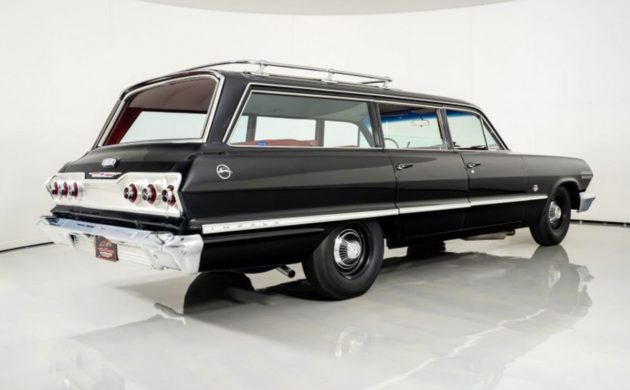
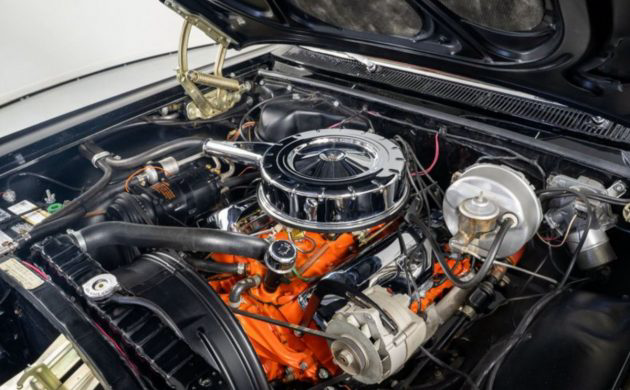
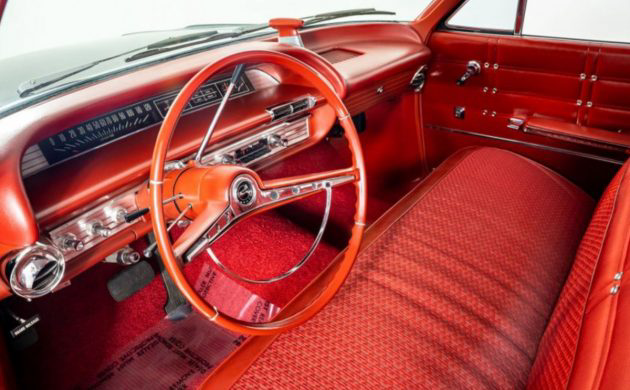
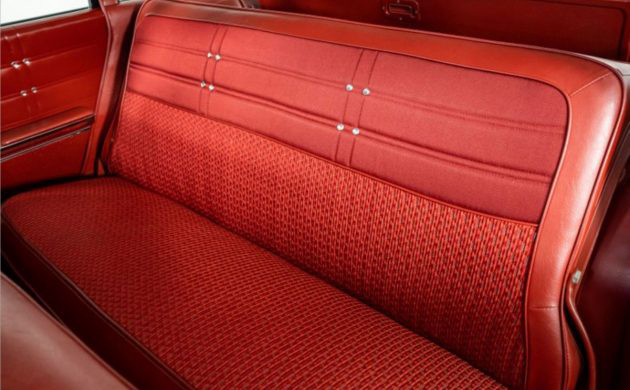
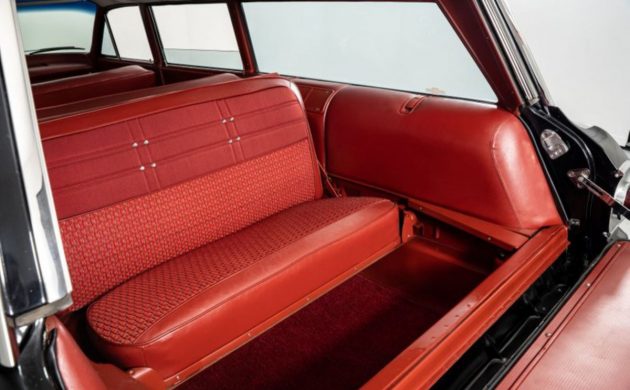
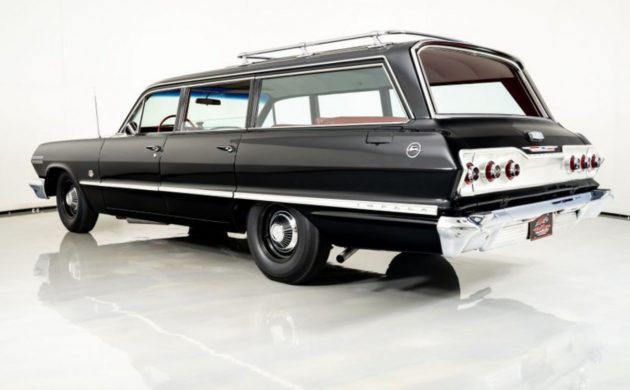
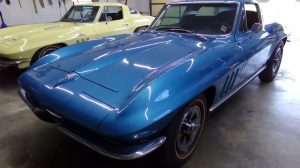
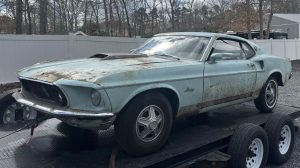




Got to be rare. I often muse about the type of buyer who would order something like this. Most of these were sixes or 283s.
People who towed ordered them. They were not that uncommon
Absolutely stunning car! But even more stunning is the floor of the Barn!
okay! THAT made me laugh. “what? your barn doesn’t look like that?”
This guy does not get his hands dirty like us poor folk who can’t even afford a lift LOL
Way, way over-restored. A cold beer says this wagon did not leave the factory with:
1. dog-dish hubcaps vs. full Impala wheelcovers
2. blackwall tires vs. whitewalls
3. power windows
4. autronic eye headlamp dimmer
5. power front seat
6. *A/C (only because vast majority of buyers didn’t opt for it)
It looks great; don’t get me wrong. Chevy restorers tend to go overboard on accessories–think `58-`59 Impalas.
I agree with the wheel covers, but otherwise, not so sure. A rich guy prob ordered this, why not load her up?
People who towed ordered them. They were not that uncommon. You are all right about the dog dish hub caps. I am sure it had white walls, full caps and perhaps even the fake woodgrain side panneling
Perhaps the original owner checked all the available options and wanted a Chevy. Most of these extra accessories were optional on all full size GMs of that era except for the higher end cars. It probably would cost considerably more for a Bonneville Safari fully equipped which was just over $5,000.
Whether the options were factory installed or added later, it looks great and is functional even today.
It’s beautiful and menacing in appearance, though not in actuality. With the increasing interest in wagons, this shouldn’t stay on the market for long.
Steve R
I agree. It’s a well executed build.
Don’t be so sure about that Will – unusually well optioned yes, but not unheard of. If the builder wanted to go all in I’d think he’d add power vent windows, tach and RH mirror too. A glance at the cowl tag would be extremely interesting though.
Remember the Impala was top of the Chev wagon pecking order and wagons being predecessor to our time’s SUV so if you wanted to tow your massive Airstream or powerboat in comfort this was the way to go. At my first(and so far only) visit to Power Big Meet in Sweden I had a long conversation with the owner of a similarly highly optioned documented ’64 Impala wagon. Sold new in Sweden and amongst the many options were 340hp 409/PG, tach,remote+RH mirror and Goldwood Yellow(new for ’64 and exclusive to Impala+SS in the fullsize line)
Even the black paint must’ve been highly unusual to being de-facto special order only on wagons. It looks like it was built for export to someplace where stock big American wagons were used as hearses.
The dash has what appears to be factory vents for the ac. Both on the perimeter and in the middle.
That’s a factory installed AC, and if you lived in the southern states in ’63 there were a lot of cars with factory AC that included my family and most of the family friends we had.
Beautiful car but are there seat belts for nine passengers? Not to sound like Ralph Nader but I wouldn’t have my kids in any seating position in it without a belt. Don’t get me wrong, I was the little kid riding back there without even a seat many years ago. Not now though.
Seat belts became law during the 1964 model year. This one likely was not built with them.
You must not have owned old cars. Seatbelt laws didn’t come in until 1968. I owned many. Currently, a 1966 and it has optional seat belts on the order.
My 65 GTO convertible has a code 414 seat-belt deletion for a credit of $11.00 Dennis is correct, 1968 was the first year of federally mandated 3 point seat belts. Seat belts were available prior to that, of course. My parents had friends that would order cars like this, basically stating they wanted every option available, not that unusual back in the day. The majority just never survived, the more options, the more likely they were junked due to failures. This car is spectacular, and nicely done.
Dennis, I have probably owned a lot more than you. The seat belt law went into effect in 1964. I remember when my Father bought his new 64 Olds. They were lap belts only.
!968 is when the shoulder belt came into play
seat belts where 1st as a option in 1956 on fords they where also a padded dash option parents bough new 1956 fairlane with them ford tried selling safety in 1956 did go over well
“The first seat belt law—federal law Title 49 of the United States Code, Chapter 301, Motor Vehicle Safety Standard—took effect in 1968. The law required manufacturers to fit seat belts into vehicles.”
Simple to find. Just gotta do the homework. I don’t doubt that your father had lap belts in the 64 but they were not required by law. They were optioned. Many car manufacturers offered them from all the way back into the 50’s.
It was 65 for lap & 68 with shoulder that had no retractable as you had to take down from clips above door openings but seat belts were available & they go back as far as 56 on a ford as a dealer option nice car yeah as much as I hate WW tires & full wheel covers it probably came with ! but like the clean performance look & yes it could of been ordered with a 4 sp.!
My guess is that this was a former GM company vehicle. It was not unusual to see the company cars ordered with everything including the kitchen sink. Mine always were.
I agree. It’s a well executed build.
I’m reading this on my phone so maybe someone viewing on a full-size monitor can tell me what the heck is under the back of the car? Both pictures of the back appear that it is parked on a culvert!
That’s a shadow cast by the artificial lighting mounted above the car. It’s an optical illusion based on the position of the various lights.
Steve R
Spectacular wagon.
Matching numbers 409. Tilt. A/C. Am/Fm. Power seats and windows. Clock. Hell, it even has the factory emergency flashers – you rarely see those. Black over red. Whats not to like?
Worth $70K?. Hmm, let me think a second.
Yep, every single penny.
A good reason for ordering the 409 in one of these is, the kids aren’t going to be constantly whining, “are we there yet” because you’ll get there, quickly.
Okay, settle down, the “409” thing is gathering all the attention, for all it’s fanfare, but IF, and I say if someone actually ordered a car like this with a 409 is because, it was the biggest motor they could get and the 409’s racing heritage had nothing to do with their decision. It’s what was needed to move a car like this, loaded with gear and Mama. Don’t forget, 9 passengers, gear and maybe a camper adds a ton of weight. Even still, I never, EVER saw a 409 in a car like this. Especially black. Wagons were for happy family colorful times, and just didn’t see many black cars. As a kid that called out every car I saw, a “409” surely would have caught my attention. The small block V8 and Powerglide were the standard options on wagons. They had to be mom compliant, there was no need for a 409. Cool find on a car that rarely existed.
Here near Pittsburgh, this car would have been used as a Turnpike cruiser. With its 65 mph speed limit, seven tunnels, and relatively steep grades cubic inches ruled. The speed limit on the Ohio Turnpike was 70, so the trip to Cedar Point was a quick one.
HoA_ Yep.on the other hand you never know. I’d like to see the cowl tag or build sheet. The colors, dog dish hubcaps and the sparkly engine compartment yell.. Build To Sell. On a more germane note, where is the rear facing third seat automatic ejection option that usually came with with the tailgate power window ? Damn kids…out with you!
In 1970 I worked at a gas station in Minneapolis and we had a regular customer that had a LOADED 1964 Impala wagon with red exterior and a red interior. Very much like this one including A/C, power windows, seats and the autronic eye. Even as a 20 year old I loved that car and told her how special it was. I suspect that it had been a factory “brass hat” car. I have always wondered what happened to that car!
“They had to be mom compliant, there was no need for a 409.” My Mother certainly didn’t agree, She always made Dad order the biggest motor. She called them the Thunderbird Motors. We had Fords, not Chevys, and Dad couldn’t stand paying for the fake wood, but A/C for those Midwestern Summers, and a block heater for winter. In the early 60’s Moms wore white gloves, she didn’t like getting the gloves dirty, but the ’63 needed an ether shot down the throat of the carb to start on the really cold mornings, she didn’t need no man around to do it. Snort, Mom compliant, Not my Mom.
Bump up the compression, cam it and put the 2×4 carbs on it, it is the ultimate wagon, unless a factory 70 Plymouth Satellite Hemi 4spd wagon surfaced.
440-6 was a Fury option for 1970-1971.
I worked for a Chevy dealership from 59-late 60’s this is the first 63 I’ve seen with the radio antenna on the left front fender.
Awesome looking wagon! My favourite years for the Chevy Impala have always been 1963 and 1964. This looks like a beautifully kept original survivor.
Only bummer is the PowerGlide. Imagine it with a 4 speed.
Triple WOW!!! One of One?
Rode along with some relatives from Jacksonville to Daytona Beach – Holly Hill and back during the summer of 1964 in a 1963 Impala SS. Blue with a white painted top and blue interior. Not as loaded as this wagon but it did have a cold a/c! Memorable trip and car.
All that money spent on the resto and the front passenger side exterior door trim doesn’t line up !!!!!
Nice enough wagon for sure but sorry to say those dog dish hubcaps are killing it along with the misaligned front passenger side door moulding. What posses people to use those hub caps ? @ Jost, woodgrain was not available till a few years later, possibly 1966 ?
Hi Moosie, I stand corrected on the woodgrain. I Realised it myself after I posted it and thank you for clarifying. I don’t get the dog dish caps with the restoration either. Lots of muscle cars came with dog dish because the original purchased did not want to buy optional hub caps because the mags we’re waiting! This car likely had white walls and full covers. There is another one posted on the Mecum site, equipped simarlarly with the full deluxe wheel covered and white walls.
@ Moosie….pie pan factory caps are a 409 thing…if you’re not a 409 fan, you’re excused.
First, seat belts were FEDERALLY MANDATED AS STANDARD EQUIPMENT FOR ALL CARS BUILT AFTER 1-1-64. 19sixty5 is right that they were available w/belt delete for credit after that time. The lap/shoulder combo came in cars from the 68 model year, and those were NOT delete-able.
My main reason for making a comment: In the 60s and 70s, I worked at a Shell station, both full and part-time, here in Portland. I was an avowed car nut from early childhood, and I was a dyed-in-wool Chevy fan. I can still recall the exact cars that many of my regular customers drove, as well as a few very unusual ones that were a one-time sighting. AC was not a common option here then except on some ‘upmarket’ cars, certainly not on a Chevy. The MOST unusual car I vividly recall was a black 63 Impala wagon w/a 409 and every option (I was an option ‘freak’ even then). AND, the car was from MISSOURI–they were visiting friends here. Now, the odds of there being TWO of these is quite small, and this car is listed in Missouri. While I really can’t believe this is the same car I saw all those years ago, the car and its location have me wondering if I should buy a lottery ticket today! One note about 63 Chevys w/fact AC. Passenger cars with AC had a rear antenna as standard as there must’ve been a problem installing/routing the cable for the normal front mount antenna. However, wagons had their antennas on the left front fender as this wagon has–an exterior giveaway to the AC.
I know you have a keen eye for details + options Chuck, and good observation on the LH antenna. 👍 I, too, observed it was on the ‘wrong’ side but didn’t give it any thought there’d be a practical reason for it.
The B-body heater/fan box layouts are indeed very different between AC/non-AC cars these years, but as a sidenote – my ’64 Bonneville Safari is a factory AC car, and being a fellow B-body it should have those same issues with antenna cable routing. But the Pontiac’s stock antenna location is on its… RH fender…(!) 🙃
You are correct. It was only Chevy and Olds that had this ‘problem’. Fact AC Oldses in 63 (& I believe 64 as well) had a manual rear antenna on the right rear quarter where the electric antennas were normally placed (wagons too). So, if you spot an Olds with a regular mast antenna on the rt. quarter, it’s an AC car. Chevys only in 63; they must’ve solved the cable routing problem for 64. Pontiac and Buick were ‘normal’.
That’s just hilarious,and also why I enjoy learning new stuff about our old rides. Brings car-geekdom to a higher level 😄
So in ’63, GM’s different B-bodies would have antenna(s) mounted in all 4 corners (LH rear if twin), all depending on AC/non-AC and what division it was!? Talk about re-inventing the wheel for a bodyshell that shares architecture! I would’ve never guessed they’d put factory antennas on the rear quarter of a wagon but then again I’ve never seen a ’63 Olds wagon w/ AC IRL either to compare (…nor do I believe many of my age group have…)
From 61-up, both Olds and Pontiac wagons w/an electric antenna had them mounted on the RR 1/4 as that’s where they were mounted on pass. cars (they were vertical mount,not slanted). Buicks had theirs on the RF in the same place as a manual antenna, and Chevy didn’t have one.
I hate to prolong this seatbelt discussion, but I want to point out exactly what was FEDERALLY MANDATED. That would be lap belts ONLY.
I admit that my experience is limited, but I know that when it came to restoring my 1970 Corvette Convertible, I found that it did not come from the factory with shoulder belts. Lap belt = absolutely.
Shoulder belts were standard for coupes and an option for convertibles. The option code for shoulder belts on a convertible in 70 – 75 was A85 and would have been listed on the window sticker.
So, if your Corvette Convertible came with lap belts, you had retractors mounted on the the rear inner fenders, and the belt passed through a cut-out in the seat-back. If you did not have that option, the cut-out did not exist.
It was the same on other GM converts. Shoulder belts opt, and they mounted in a similar manner on those.
there where no shoulder belts in 68 69 or 70 71 or 72 was buying new every year back then none with shoulder belts they came in 80s
Then you must not have been paying much attention to your new cars. Shoulder belts were FEDERALLY MANDATED on cars for the 68 model year (and thereafter). They were separate from lap belts and were stored along the headliner/window opening in a retainer. The had to be separately attached to the belt buckle along with the lap belt. A hassle and uncomfortable to use, they generally spent their existence in the retaining clip unused. The 74 model year brought the infamous ignition interlock, and the shoulder belts were now sewn together with the lap belts so they were ‘one-piece’ belts (however, it wasn’t hard to cut the threads and put the shoulder belts back to separate so the lap belts could be used as normal–I did that to my 75 Caprice). The one-piece belts we see today started appearing in the later 70s/early 80s.
‘Thems the facts’!!! One poster mentioned that he had a window sticker showing optional belts. Yes, the standard equipment OE belts from 64, when they became standard, came only in black and on Chevys at least they had a black plastic buckle. Deluxe COLOR KEYED BELTS were an option, and those (including the black ones) had chromed buckles. So an option for belts from 64 up would have meant the deluxe color keyed belts, not the standard ones.
Chuck, you are right on the money! Anyone that argues with your statements needs to go back to schoo;.
Go back to school indeed…my parents tried to have the seat belts removed from a 1965 Vista Cruiser they bought from Dewar Olds in Homestead, Pennsylvania, to avoid a “sports car” surcharge on the insurance but the dealer refused.
The first car I had with the shoulder belt was a 1971 Fury. Neither my 68 Camaro or 69 Charger R/T had them but they did have lap belts. Light trucks came later. My dad’s 73 F100 had only lap belts but my 77 F150 had an integrated lap/shoulder belt.
Dave, that may not be the stupidest thing I’ve ever heard, but it’s damned close.
I mentioned a lot of things; be specific, please.
My moms 68 Rebel had Shoulder Belts and My 70 Impala also had them they were attached to the roof and clipped above the door glass, Made it a real PITA to get down once you were sitting in the car………..There is a factory GM option you may find satisfactory. I had no problem with them. Check out the way 3 point seat were mounted in late 60s early 70s hardtops like Chevelles, Monte Carlos and Impalas. In the 70-72 Chevelle, Monte Carlo and I assume the Impala had an interesting early 3 point system. Basically it was a lap belt with a non retractible shoulder belt that clipped into the lap belt. It had chrome clips above the window that held the shoulder belt out of the way when not in use. The roof was reinforced in that area to capture the the shoulder belt attachment.
@ Al…..you’re waaaay off the mark, Al. P/u some era-correct factory sales literature & be educated re/shoulder belts.
“Dennis”, you really need to check your facts. YES, seat AND SHOULDER BELTS came out in 68, but lap belts were standard after 1-1-64. Those are TWO DIFFERENT THINGS. You can believe whatever you want, but if I agreed with you, then we’d BOTH be wrong!
There’s really nothing to argue about. My statement was a quoted from the United States Motor Vehicle Safety Standards Board so I kinda prefer to believe them. And the fact that I and my friend both have 100% oroginal 66 cars with no lap belts. My friend bought his new.
AND, did you notice that I stated that AFTER 1-1-64, when lap belts were STANDARD EQUIPMENT, they COULD BE DELETED FOR CREDIT? If you happen to read a Chevy brochure for 64 (revised edition), 65 or 66 you will see them listed as std. equipment. In the Chevy dealer color and upholstery albums for those years, all the optional factory equipment is shown. Two belt options existed–delete for credit, or optional custom color-keyed belts w/deluxe buckles. YOUR statement applies to the lap/shoulder belt requirement. THAT IS DIFFERENT THAN LAP ONLY!!! This is for ALL CARS built after that 1-1-64 date. INCLUSIVE. You are comparing apples to oranges here.
Chuck, you’re wasting your breath. The more you try to talk sense, the more argument you get from people like this.
The lap belts back then were easily pushed down into the cushions and typically laid on the floor under the seat unseen unless the owner went digging for them. Perhaps your car had them, but the dealership had pushed them down, or maybe even uninstalled them. Who knows for sure, but you can be inspectors would have been all over new safety item stuff at the factory. No way the big 3 would skip that and risk the federal lawsuit. The original lapbelts had such a tendency to fall and get hidden, I bet anything the engineers designed them to do it on purpose since they probably felt the belts screwed up their beautiful design.
This has to be the most optioned ’63 Chevy Impala Wagon existing today. I would love to know if this was a COPO order. It’s one of just a few Chevrolet cars I would want in my garage. Years ago I had a fully optioned ’63 Impala 4-door hardtop in Maroon, and regret selling it.
A little known fact: The 1963/64 Impala 4-door hardtop roof, is the same roof pressing used on the 1963/64 Cadillac Coupe De Ville!
Yes the 63 4drht chevy is still one of my favorites ! I was 9 went I first saw it new and yes the windshield inter-change with the 63-64 caddy coupe as I worked on his car in the 80s & 90s I still own a 63 4drht ! 63 are beautiful cars I like this wagon but hate red interior ! that’s just me
Looks like refugee from a funeral parlour.
Ok, on the antenna thing. I don’t know or never thought about it before. But I do remember issues of where the factory parked the POWER ANTENNA. Because if you remember, access to the heater blower motor was through the STEEL inner fender. In many GM cars, there was actually a stamped depression on the inner fender as to where to cut the hole in order to remove the blower motor. (Warranty repair kit consisted of sheet metal screws, a metal tab or 2 and duct tape. I handed out plenty as I worked in the parts department of a Pontiac store.) A power antenna in the wrong place would have required the removal of the fender to replace the blower motor.
Wow, that is a memory that just boiled to the surface!
Beautiful car. And i was oh so happy til about 2/3rds of the way through the comments when someone finally ruined everything by suggesting this car would be “perfect with a 4 speed”. Lame O. For 1 this car is perfect and standard transmissions dont need to be in everything. Especially this sweet little grocery getter people mover.
Thanks for wrecking the comment section.
Some particularly rare options here, ie. 1st year for AM/FM & tilt-wheel. All that’s needed is the factory tach.
@ chuck dickinson……..but I can attest that Buick changed their electric antenna location sometime later. My ’92 Roadmaster sedan has its electric antenna mounted thru the RR quarter.
That’s some 30 years after the cars under discussion.
I have a question and promise not to mention seat belts… Is the roof rack aftermarket or a dealer add? It seems “clunkier” than something OE to me, just an opinion; please don’t lambast me haha.
Steven,
In the late 1960s and early 1970s I worked in the new car departments of various dealerships. One of the jobs I had was installing the factory roof racks. These were in long boxes in the back wagon area. and the racks were listed on the window invoices.
One general manager from a Buick/Pontiac Dealership told me that the factory didn’t install the racks because there were many potential buyers who would say “I don’t want the roof rack”, and if it had been installed, drilling 8 to 12 screw holes into the steel roof, meant they were unable to make the sale. So if the sale included the rack, GM paid 3/10ths of an hour for me to install the rack.
I also installed quite a few roof racks on Ford Country Squires, Torinos, even little Pinto wagons got racks, and many of them came thru the delivery process with the rack in boxes, in the car.
And on a side note; When my dad was looking to buy a new wagon in 1967, he looked at a new Pontiac Executive wagon. it was equipped with a cheap J.C. Whitney type roof rack that had already began rusting at the connecting points.
Dad said he didn’t want that rack, and the dealer said no problem, we can remove it, but we’ll have to install a vinyl top over the entire roof. I took my dad aside and said all they are gonna do is put the vinyl top over the existing holes! He said he already figured that out, and he told the salesman if he decided to buy one, it would be a car they had to order.
So we did test drive the Executive wagon, and it actually ran out of gas in front of Maryland Motors, the Chrysler-Plymouth dealership. The guys there were so nice in helping push the car into their dealership, and while waiting for the Pontiac salesman to bring them our car back, dad ended up buying a big Fury II wagon, with an extra-long roof rack of course!
The reason that GM did not ship vehicle’s with the rack installed, in the old days, was because of possible transportation damage by the carriers.